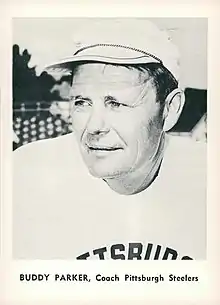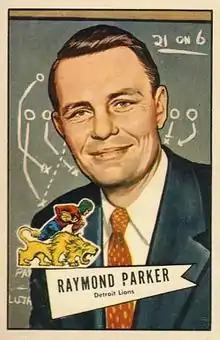Buddy Parker
Raymond "Buddy" Parker (December 16, 1913 – March 22, 1982) was a football player and coach in the National Football League who served as head coach for three teams: the Chicago Cardinals, the Detroit Lions and the Pittsburgh Steelers. He is only one of two former head coaches to win multiple championships while serving in that position (other than George Seifert) and not yet enshrined in the Pro Football Hall of Fame, despite eligibility.
 | |||
| Position: | Fullback, linebacker, defensive back | ||
|---|---|---|---|
| Personal information | |||
| Born: | December 16, 1913 Slaton, Texas | ||
| Died: | March 22, 1982 (aged 68) Kaufman, Texas | ||
| Height: | 6 ft 0 in (1.83 m) | ||
| Weight: | 193 lb (88 kg) | ||
| Career information | |||
| High school: | Kemp (TX) | ||
| College: | North Texas & Centenary | ||
| Career history | |||
| As player: | |||
| |||
| As coach: | |||
| |||
| Career highlights and awards | |||
| |||
| Career NFL statistics | |||
| |||
| Head coaching record | |||
| Regular season: | 104–75–9 (.577) | ||
| Postseason: | 3–1 (.750) | ||
| Career: | 107–76–9 (.581) | ||
| Player stats at PFR | |||
| Coaching stats at PFR | |||
Playing career
Parker grew up in Kemp, Texas, just outside Dallas, and played collegiately for Centenary College in Louisiana for three years beginning in 1932. Parker then signed with the Lions as a fullback in 1935, and during his first season, he helped the team capture the NFL championship. After one more year in the Motor City, he was traded to the Cardinals and spent the next seven seasons with Chicago, also seeing time on defense as a linebacker and defensive back. During the latter two years, he added the duties of backfield coach before becoming a full-time assistant in 1945.
Coaching career

In 1947, the Cardinals captured their second (and only undisputed) NFL title, then lost in a blizzard in the following year's championship clash at Philadelphia. On February 3, 1949, he and Phil Handler were named co-head coaches of the Cardinals, replacing Jimmy Conzelman, who had left to work for a local advertising agency. The unique arrangement, which had Parker handling the offense and Handler the defense, quickly proved to be unworkable, and Handler was returned to the front office on October 25 with the Cardinals sporting a 2-4 record.
In the season's final six games, Parker's team won four games, but a 52-20 loss to the crosstown Bears was quickly followed by Parker's surprising resignation on December 11. Publicly he stated, "I'm tired of being a head coach. The duties are too demanding", but Parker also reportedly was upset with his uncertain job status.
After first reconsidering his abrupt departure, Parker then signed as backfield coach of the Lions January 21, 1950. However, after head coach Bo McMillin found himself in continuous battles with players during the ensuing campaign, he resigned on December 19, with Parker being promoted to the top job the following day.
Parker and quarterback Bobby Layne would popularize what became known as the two-minute offense, which allowed a team's offense to quickly move down the field late in a game. In Parker's first year, he led the team to a 7-4-1 record, good for a second place tie in the Western Conference. While the record was slightly better than average, he began bringing in the talent that would turn the team into a dominant force over the next few years.
Parker's superstitions also became legendary, with none of his players ever wearing the number 13, and the team always staying at the Chicago Hilton hotel when playing either the Bears or Cardinals. That choice of lodging changed after the team was placed one year on the 13th floor and lost.
The 1952 NFL season saw the Lions defeat the Los Angeles Rams in a divisional playoff on December 21, then use a strong defensive effort to defeat the injury-plagued Cleveland Browns on the road by a 17-7 score. In 1953, the two teams again met for the title, with some late heroics by Layne and Jim Doran helping to squeeze out a 17-16 thriller in the December 27th game.
Putting together a 9-2-1 mark in 1954, the Lions and Browns met for the third straight year, but this time, Cleveland battered Detroit by a 56-10 score. The after-effects of the result lasted throughout the following year, when retirement and injuries plunged the Lions to a 3-9 last-place finish. Parker was able to make another run for the title in 1956, but the Lions dropped the season finale to the Bears, the key play coming when Layne was knocked out of the game with a concussion from a hit behind the play that Parker felt was both cheap and illegal.
On July 26, 1957, Parker obtained quarterback Tobin Rote, a prescient move that would help the team when Layne broke his ankle and Rote then led the Lions to their third championship in six years. However, Parker would not be around to enjoy the championship season after stunning the football world by resigning on August 12 during the team's preseason training camp dinner. In front of a large audience which expected him to deliver a keynote speech, Parker instead informed the audience that he was quitting. George Plimpton wrote of this incident in his 1966 best-seller Paper Lion. In his resignation Parker cited an inability to control his players, but his struggle in obtaining a two-year contract from Lions' management also likely played a role.
After first reports had him replacing Baltimore Colts head coach Weeb Ewbank, Parker would instead take over the Steelers on August 27, signing a five-year contract. During his first season, Parker led the team to a 6-6 mark and began making countless trades that left the team with few top draft choices over the next six years.
During the 1958 preseason, Parker attempted to get the players' attention by cutting five veterans, including Billy Wells, the team's leading rusher the previous season. He also reunited with Layne, trading for the signal caller on October 6. The price (quarterback Earl Morrall and two first round draft picks) was steep, but the immediate impact was evident: the team improved to 7-4-1, the team's best record in a decade.
The next two years, the Steelers managed to compete at a .500 level, but dropped to 6-8 in 1961. The next year, the team finished second in the Eastern Conference with a 9-5 mark, then came within one game of competing in the 1963 NFL championship game before falling to the New York Giants. During the latter year, the team challenged despite the retirement of Layne and the tragic off-season death of Eugene "Big Daddy" Lipscomb.
The aging team then began a decline that would continue until the arrival of Chuck Noll in 1969. During the 1964 NFL season, Parker's team finished 5-9, but Parker signed a three-year deal on January 22, 1965, saying that the team was not that far away from a championship. He would change his mind when the team dropped its first four exhibition games, and repeated history by resigning on September 5, reportedly telling team owner Art Rooney, "I can't win with this bunch of stiffs."
Throughout his coaching career, Parker went 104-75-9, with a .577 winning percentage, while going 3-1 in the postseason. He is one of 43 NFL coaches to have over 100 coaching regular season victories. The Professional Football Researchers Association named Parker to the PRFA Hall of Very Good Class of 2008.[1]
In 2020, he was named a coaching finalist for the first time as a part of the Pro Football Hall of Fame's "Centennial Slate." He was again up for the class of 2021, but was among the coaches part of the final cut.[2]
Later life
Parker never again coached, spending much of his remaining years in the real estate field, but he did receive job offers. In January 1966, he was under consideration for a Rams' assistant position under George Allen, then was a candidate for head coach of the Washington Redskins in December 1968. He was a special assistant under Bud Wilkinson on the 1978 St. Louis Cardinals.
On March 7, 1982, he underwent surgery for a ruptured ulcer, but complications left him unconscious until his death 15 days later.
Head coaching record
| Team | Year | Regular season | Post season | |||||||
|---|---|---|---|---|---|---|---|---|---|---|
| Won | Lost | Ties | Win % | Finish | Won | Lost | Win % | Result | ||
| CHI | 1949 | 6 | 5 | 1 | .545 | 3rd in NFL Western Division | - | - | - | - |
| CHI Total | 6 | 5 | 1 | .545 | 0 | 0 | .000 | - | ||
| DET | 1951 | 7 | 4 | 1 | .636 | 2nd in National Conference | - | - | - | - |
| DET | 1952 | 9 | 3 | 0 | .750 | 1st in National Conference | 2 | 0 | 1.000 | Won National Conference Playoff over Los Angeles Rams Won NFL Championship over Cleveland Browns |
| DET | 1953 | 10 | 2 | 0 | .833 | 1st in Western Conference | 1 | 0 | 1.000 | Won NFL Championship over Cleveland Browns |
| DET | 1954 | 9 | 2 | 1 | .818 | 1st in Western Conference | 0 | 1 | .000 | Lost NFL Championship to Cleveland Browns |
| DET | 1955 | 3 | 9 | 0 | .636 | 6th in Western Conference | - | - | - | - |
| DET | 1956 | 9 | 3 | 0 | .750 | 2nd in Western Conference | - | - | - | - |
| DET Total | 47 | 23 | 2 | .671 | 3 | 1 | .750 | |||
| PIT | 1957 | 6 | 6 | 0 | .500 | 3rd in Eastern Conference | - | - | - | - |
| PIT | 1958 | 7 | 4 | 1 | .625 | 3rd in Eastern Conference | - | - | - | - |
| PIT | 1959 | 6 | 6 | 0 | .500 | 4th in Eastern Conference | - | - | - | - |
| PIT | 1960 | 5 | 6 | 1 | .458 | 5th in Eastern Conference | - | - | - | - |
| PIT | 1961 | 6 | 8 | 0 | .429 | 5th in Eastern Conference | - | - | - | - |
| PIT | 1962 | 9 | 5 | 0 | .643 | 2nd in Eastern Conference | - | - | - | - |
| PIT | 1963 | 7 | 4 | 3 | .636 | 4th in Eastern Conference | - | - | - | - |
| PIT | 1964 | 5 | 9 | 0 | .357 | 6th in Eastern Conference | - | - | - | - |
| PIT Total | 51 | 47 | 6 | .520 | 0 | 0 | .000 | - | ||
| Total | 104 | 75 | 9 | .581 | 3 | 1 | .750 | |||
See also
- List of National Football League head coaches with 50 wins
References
- "Hall of Very Good Class of 2008". Archived from the original on October 3, 2018. Retrieved November 23, 2016.
- https://twitter.com/WixieEarlWilson/status/1295908169651236866?s=20